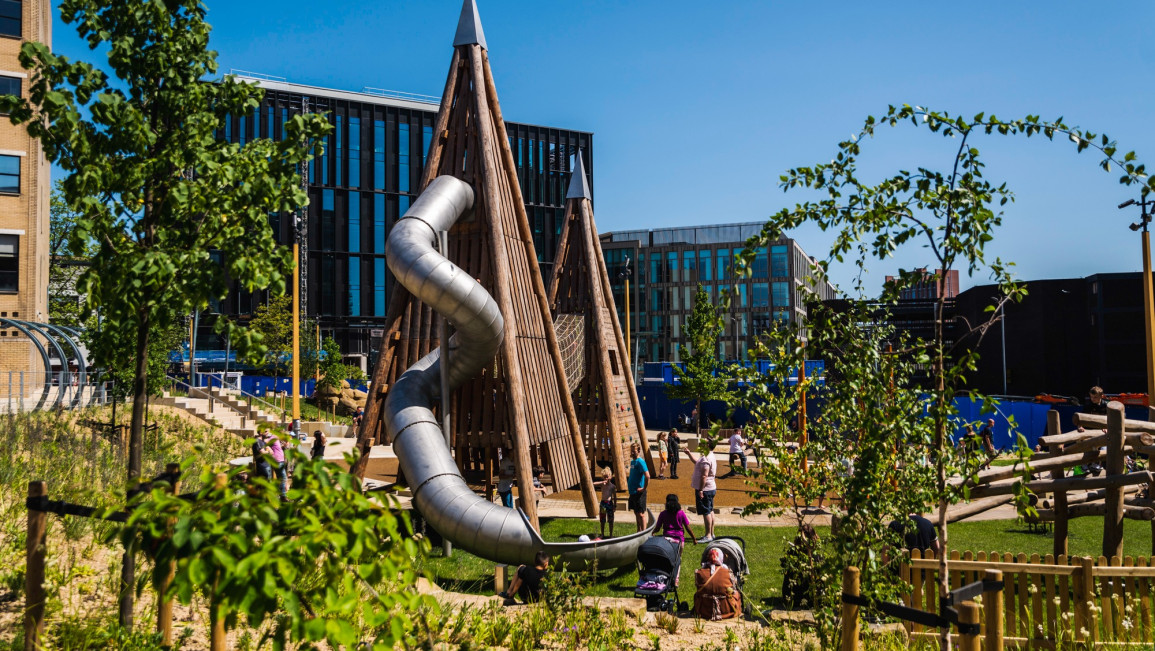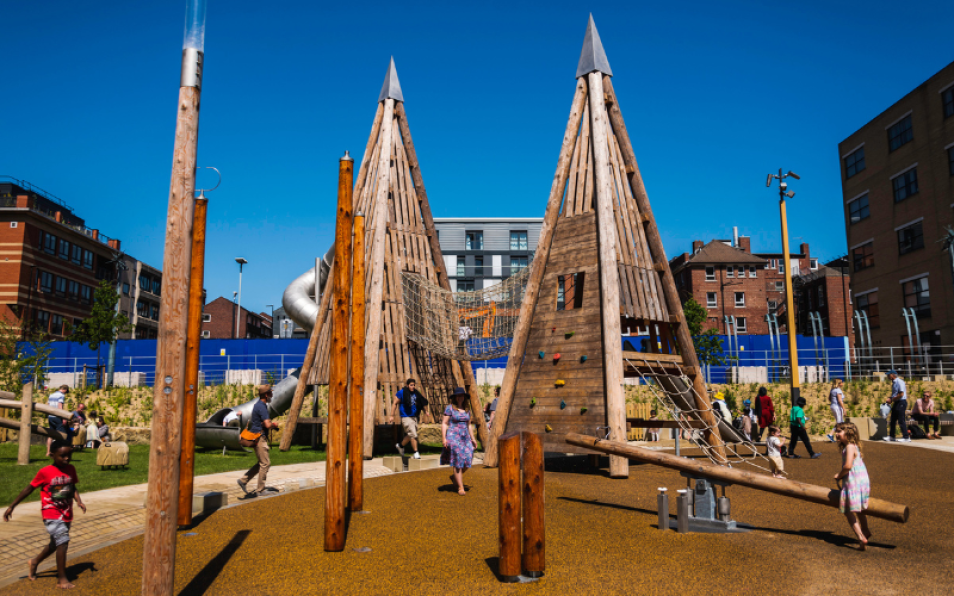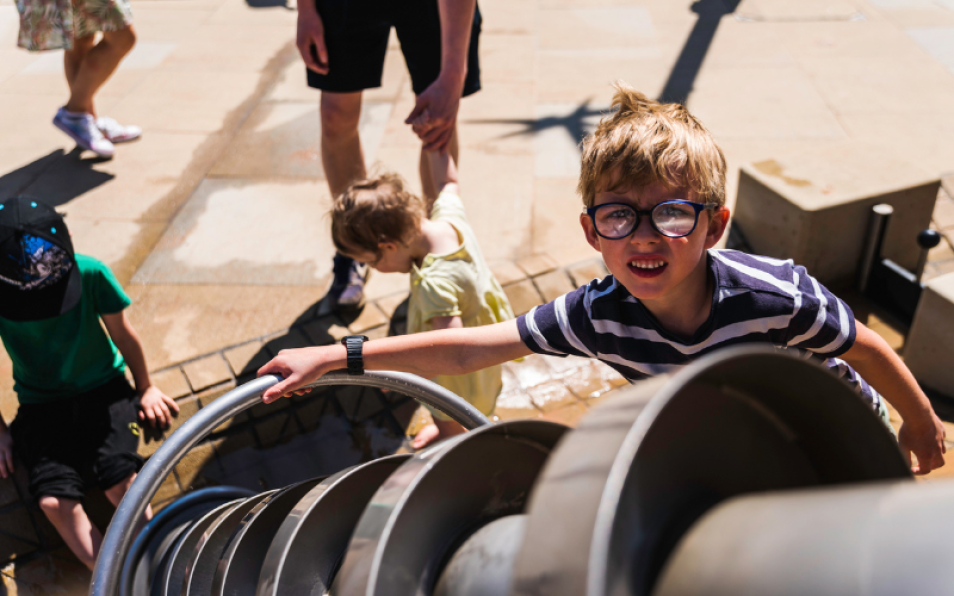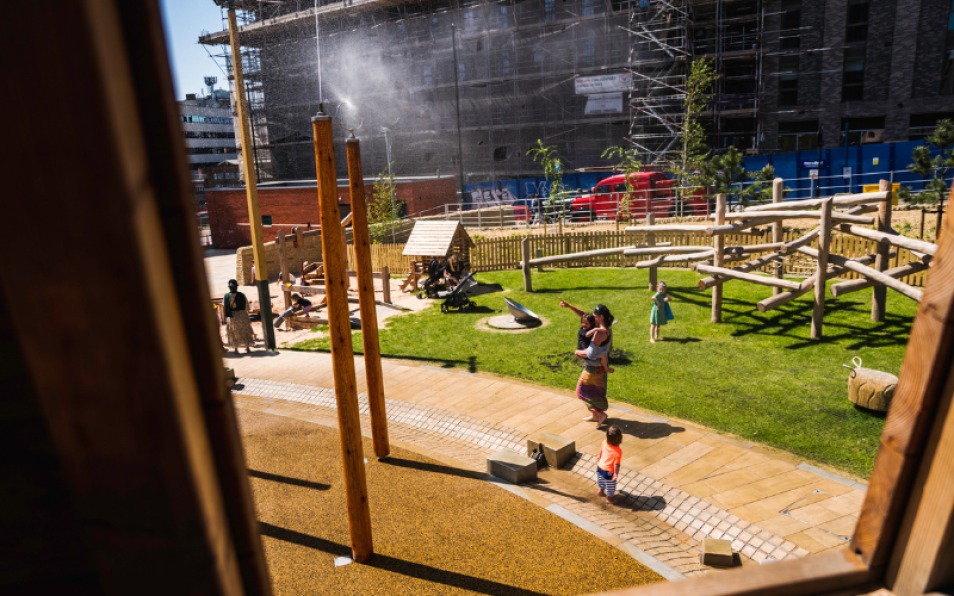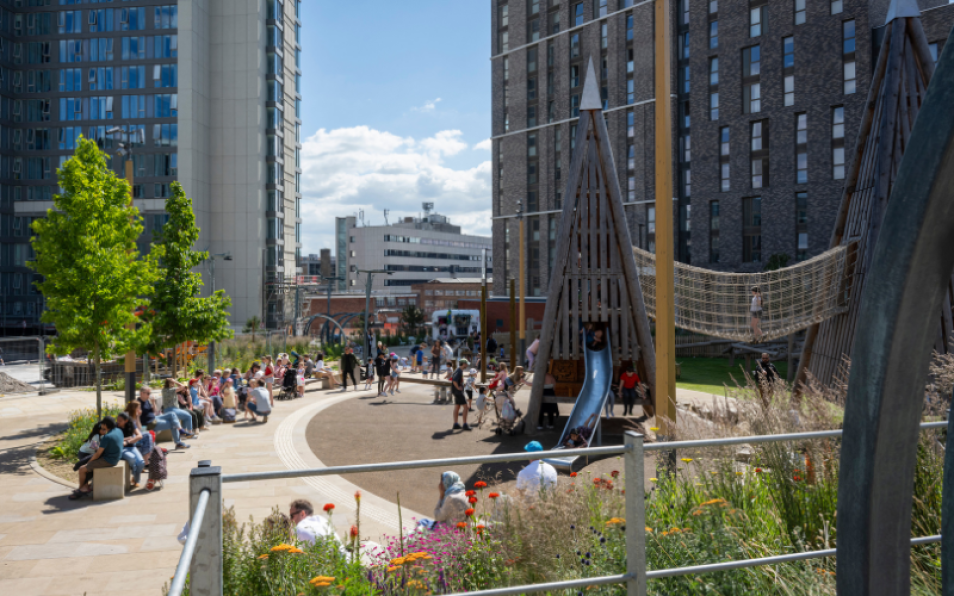Ideas and Insights
Cities thrive when they foster genuine connections between people and place. Across the UK, forward-thinking councils and developers are discovering that playful placemaking transforms urban spaces into vibrant community assets. By positioning community play spaces at the centre of regeneration strategies, towns and cities are creating environments that enhance wellbeing, strengthen social bonds, and drive economic growth.
How Play Drives Regeneration and Social Cohesion
Sheffield's Pounds Park demonstrates excellence in playground design through strategic investment. As part of the city's £480 million Heart of the City regeneration scheme, the council chose to create an ambitious play space rather than additional parking provision – a decision that has redefined what destination playgrounds in the UK can achieve.
The park's design incorporates wooden towers, climbing walls, wooden playhouses, climbing boulders, and stainless steel slides, creating multiple play experiences for diverse age groups. The water play equipment extends beyond traditional features, offering an engineering playground where children collaborate to pump, divert, and channel water flows – developing problem-solving skills through play.
Thousands of visitors attended the park during its opening week, with momentum continuing as Andrew Davison from Queensberry observed: "From children running around the play area to city centre workers enjoying their lunch in the sun, it's great to see that we are making spaces that add real value to the local community"
The sustainability credentials are equally impressive. The park incorporates 340m² of rain gardens providing infiltration for adjacent surface water run-off, seamlessly connecting to Sheffield's award-winning Grey to Green Sustainable Drainage System. This integrated system prevents 24,000 bathtubs' worth of water from entering Sheffield's sewage treatment works annually, whilst achieving up to 80% flow rate reduction during high intensity rainfall events.
This demonstrates how child-friendly city initiatives in the UK deliver tangible outcomes – creating spaces that serve multiple functions whilst enhancing urban resilience.
Rethinking Planning for Future Generations
Dr Jenny Wood from A Place in Childhood has conducted extensive research at Pounds Park, gathering evidence for the Town and Country Planning Association on effective approaches to playground installation and urban development.
The consultation process engaged over 500 individuals across one year through RivelinCo's 'Bright Sparks in Pound's Park' initiative, incorporating workshops focused on Sheffield's heritage, green spaces, and future aspirations. These sessions integrated physical crafting, drama, dance, and creative writing – ensuring meaningful participation rather than tokenistic consultation.
The resulting publication, Child-Friendly Places: Case Studies from England, Scotland, and Wales, presents compelling evidence from Aberdeen, Wrexham, East London's Chobham Manor, and Sheffield. The research demonstrates that child-centred design principles benefit entire communities, not just young people.
The findings challenge conventional planning approaches, advocating for fundamental reimagining of public space purposes and priorities.
Agile Interventions in Town Centres
Strategic interventions need not require Sheffield's investment levels. Stockport's Play on the Way project demonstrates how modest budgets can achieve significant impact. Castle Street in Edgeley has been transformed with natural play structures and informal seating in underused pedestrianised areas, delivered in partnership with outdoor play equipment specialists Timberplay.
Civic and Social's approach distributed playful elements throughout the streetscape – creating moments of discovery through interactive features that activate previously neglected spaces.
Stockton-on-Tees represents an ambitious investment in play-led regeneration. The £23 million transformation of their town centre into a sustainable playground destination is funded through £20 million from Tees Valley Combined Authority and £16.5 million from the government's Future High Streets Fund
The centrepiece features two timber towers, each exceeding ten metres in height Esh Group, incorporating wheelchair accessible play equipment and integrated sensory play equipment – establishing a landmark destination for the region.
Mark Grimshaw, Associate Director at Timberplay, who has guided this project through extensive planning processes, observes:
"Over the past decade, the role of town and city centres has shifted dramatically. With retail no longer the sole draw, councils must create vibrant, family-friendly spaces that bring communities together and encourage people to stay longer. Destination play areas are a fantastic way to do this."
The consultation process demonstrated best practice, with Stockton Parents Carers Forum ensuring the inclusive playground equipment genuinely serves children with additional needs through meaningful engagement.
Playful Placemaking: A Global Movement
The UK's initiatives align with international best practice. Madrid invested €450 million in burying the M-30 motorway to create Madrid Río – a seven-kilometre linear park featuring seventeen distinct play areas, each offering unique experiences.
Rotterdam's transformation provides valuable lessons. Labelled in 2006 as the worst Dutch city for raising children, the city responded with approximately €20 million investment between 2006 and 2010 in child-friendly initiatives, comprehensively redesigning parks, schools, streets, and public squares.
Erasmus University research found that in target neighbourhoods "the population boomed, as did the local economy. Moreover, the inhabitants didn't feel displaced. Both original inhabitants and middle-class newcomers saw the transformation as positive" Rethinking Childhood. Rotterdam has transformed from a city losing families to one with waiting lists for family housing.
The evidence is clear: designing for children creates spaces that benefit all demographics. Prioritising vehicles creates environments that serve neither people nor place effectively.
Empowering Change: Why Meaningful Consultation Matters
One organisation that has particularly captured Timberplay’s attention is MATT+FIONA, a social enterprise committed to empowering children and young people to actively shape the public spaces where they live, learn, and play.
Through hands-on workshops, the team invites young participants to imagine how their built environment could be shaped and improved. Then, working alongside them with real tools and materials, they help bring those ideas to life. This immersive process of design and fabrication not only gives young people a voice, but also deepens their understanding of how surroundings influence behaviour and fosters the confidence to drive meaningful change.
We see this as next-level consultation. An approach that goes beyond collecting opinions to truly engaging young people in the act of creation. It enables them to see the immediate impact of their contributions, ignites imagination and creativity, and encourages them to question and influence the planning decisions that shape their everyday lives.
Matt Springett, co-founder of MATT+FIONA, explains:
“I’ve worked in architecture for many years, and over time I became increasingly frustrated by how our public spaces were becoming less welcoming to young people. Environments were growing more uniform and sanitised, spaces where joy, delight, and play were being designed out.
I felt the industry needed youth input in shaping the public realm, especially the places where children play. I’m passionate about hearing from young people of all backgrounds who care deeply about creating better environments for everyone. Through our work, we aim to place young people at the heart of the design process and spark something within them, encouraging them to recognise that they have a valid role in shaping better spaces, and that their opinions, creativity, and ideas truly matter. They matter.
This approach – authentic co-creation rather than performative consultation – distinguishes successful community play spaces from underutilised facilities.
The Commercial Reality: Making the Business Case
Procurement processes demand robust evidence. Every UK playground manufacturer understands the requirements of competitive tendering and value engineering. The conversation is shifting through compelling data.
Sheffield's Grey to Green scheme achieved a 561% increase in biodiversity value alongside drainage benefits. Pounds Park incorporated 39 new trees and over 70 species of planting, demonstrating that environmental enhancement and play provision work synergistically.
Contemporary playground development transcends traditional equipment provision. It requires adherence to EN 1176 playground standards whilst delivering innovation. It demands sustainable playground materials engineered for generational durability. It necessitates proving that urban playground design generates quantifiable social, economic, and environmental returns.
What Happens Next?
The transformation is gaining momentum nationally. Bristol has committed significant investment to play-led regeneration. Manchester is converting parking infrastructure into play spaces. Newcastle is integrating water play equipment along the Quayside. Leeds is pioneering "play streets" that reclaim residential roads for community use.
The critical question remains: will this momentum sustain through economic challenges and shifting political priorities?
Sheffield provides the answer. Observe intergenerational interaction at the water features. Witness teenagers choosing to spend time teaching younger children techniques on play equipment. Note the infrastructure supporting active travel – cycles secured, pushchairs accommodated, community connections forming.
Sheffield City Council's decision to maintain night-time access to Pounds Park, with carefully designed lighting ensuring welcoming ambiance, has resulted in thousands of new visitors to the city centre throughout the year.
This represents more than playground provision. It demonstrates commitment to public spaces that inspire joy, prioritise people over vehicles, and create experiences worth sharing.
When confronted with proposals for additional parking, retail units, or generic mixed-use developments, present the evidence from Pounds Park, Stockport's creative interventions, and Stockton's ambitious transformation. Demonstrate how cities flourish when they recognise their youngest residents deserve equal consideration in planning decisions.
Urban centres' futures don't lie in competing with digital commerce or attempting to resurrect obsolete retail models. Success comes through creating irreplaceable experiences, fostering genuine community connections, and building memories that endure beyond any transaction.
Experience this transformation firsthand at Sheffield's Pounds Park – where innovation in play design meets community need, creating spaces that truly serve their purpose.
Sources and References
Sheffield Pounds Park & Grey to Green
-
Sheffield's Pound's Park is a nod to the city's past - Yorkshire Bylines (April 2023)
https://yorkshirebylines.co.uk/region/sheffields-pounds-park-is-a-nod-to-the-citys-past/ -
Pounds Park Sheffield: Heart of the City project adding 'real value to local community' - The Star (April 2023)
https://www.thestar.co.uk/news/people/pounds-park-sheffield-heart-of-the-city-project-adding-real-value-to-local-community-4117553 -
Fantastic start for Sheffield's latest outdoor space - Queensberry Real Estate (April 2023)
https://www.queensberryrealestate.com/post/fantastic-start-for-sheffield-s-latest-outdoor-space -
Festival of place - Pound's Park, Sheffield - The Pineapples Awards 2024
https://www.festivalofplace.co.uk/project-showcase/gallery-shortlisted-entries-for-the-pineapples-awards-2024/pounds-park-sheffield-for-sheffield-city-council-with-get-building-fund-planit-henry-boot-construction-whittam-cox-architects-dudley-engineers-riveline-julian-stocks-and-timberplay -
Grey to Green – Sheffield - Official Project Website
https://www.greytogreen.org.uk/ -
Grey to Green Project Case Study - Connected By Water
https://connectedbywater.co.uk/casestudies/grey-to-green/ -
Grey to Green in Sheffield: creating the UK's largest inner city 'Green Street' - High Street Task Force (April 2022)
https://www.highstreetstaskforce.org.uk/resources/details/?id=0a7e2328-b0b1-4cf8-a504-ea11c544590a
Rotterdam Child-Friendly City Initiative
-
How a focus on child-friendliness revived one city's fortunes - Rethinking Childhood (July 2019)
https://rethinkingchildhood.com/2018/04/26/rotterdam-child-friendly-city-urban-planning-gentrification/ -
Are child-friendly city approaches being used to push out poor families? - Rethinking Childhood (January 2020)
https://rethinkingchildhood.com/2013/03/25/rotterdam-child-friendly-city-push-out-poor-families/
Stockport Play on the Way
-
'On The Way Play SK' launches in Edgeley with 'Portable Play Time' and 'A Child's Eye View' Play Trails - Stockport Council
https://www.stockport.gov.uk/news/on-the-way-play-sk-launches-in-edgeley
Stockton-on-Tees Waterfront Urban Park
-
Huge timber towers mark start of 'iconic' play area construction in Stockton Waterfront development - Esh Group (August 2025)
https://www.eshgroup.co.uk/news-social/huge-timber-towers-mark-start-of-iconic-play-area-construction-in-stockton-waterfront-development/ -
Ground broken on new urban park at Stockton Waterfront as it's hailed 'high street for 21st Century' - Teesside Live (December 2023)
https://www.gazettelive.co.uk/news/teesside-news/ground-broken-new-urban-park-28280807 -
First Spade in Ground for Iconic Stockton Waterfront Scheme - Construction Superintendent (February 2024)
https://consupt.com/2024/01/first-spade-in-ground-for-iconic-stockton-waterfront-scheme/ -
Stockton Waterfront urban park - Stockton-on-Tees Borough Council
https://www.stockton.gov.uk/article/8728/Stockton-Waterfront-urban-park
Additional Resources
-
Three pathways towards child-friendly cities - Cities4Children (February 2024)
https://cities4children.org/blog/three-pathways-towards-child-friendly-cities/ -
Trend-setting at local government level: Rotterdam standard for outdoor play areas - Playground@Landscape
https://playground-landscape.com/en/article/1513-trend-setting-at-local-government-level-rotterdam-standard-for-outdoor-play-areas.html
